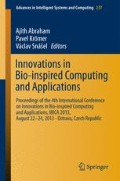Abstract
This article presents a feature selection and classification system for 2D brain tumors from Magnetic resonance imaging (MRI) images. The proposed feature selection and classification approach consists of four main phases. Firstly, clustering phase that applies the K-means clustering algorithm on 2D brain tumors slices. Secondly, feature extraction phase that extracts the optimum feature subset via using the brightness and circularity ratio. Thirdly, reduct generation phase that uses rough set based on power set tree algorithm to choose the reduct. Finally, classification phase that applies Multilayer Perceptron Neural Network algorithm on the reduct. Experimental results showed that the proposed classification approach achieved a high recognition rate compared to other classifiers including Naive Bayes, AD-tree and BF-tree.
This work was partially supported by Grant of SGS No. SP2013/70, VSB - Technical University of Ostrava, Czech Republic., and was supported by the European Regional Development Fund in the IT4Innovations Centre of Excellence project (CZ.1.05/1.1.00/02.0070) and by the Bio-Inspired Methods: research, development and knowledge transfer project, reg. no. CZ.1.07/2.3.00/20.0073 funded by Operational Programme Education for Competitiveness, co-financed by ESF and state budget of the Czech Republic.
Access this chapter
Tax calculation will be finalised at checkout
Purchases are for personal use only
Preview
Unable to display preview. Download preview PDF.
References
Moftah, H.M., Hassanien, A.E., Shoman, M.: 3D brain tumor segmentation scheme using K-means clustering and connected component labeling algorithms. In: IEEE International Conference in Intelligent Systems Design and Applications (ISDA), Cairo, Egypt, pp. 320–324 (2010)
Dash, M., Liu, H.: Feature selection for Classification. Intelligent Data Analysis 1(3), 131–156 (1997)
Chen, Y., Miao, D., Wang, R., Wu, K.: A Rough Set Approach to Feature Selection Based on Power Set Tree. Knowledge-Based System 24, 275–281 (2011)
Guo, Q.L., Zhang, M.: Implement web learning environment based on data mining. Knowledge-Based Systems 22(6), 439–442 (2009)
Pawlak, Z.: Rough sets. International Journal of Computer and Information Science 11(5), 341–356 (1982)
Swiniarski, R.W., Skowron, A.: Rough set methods in feature selection and recognition. Pattern Recognition Letters 24, 833–849 (2003)
Pawlak, Z.: Rough sets: Theoretical aspects of reasoning about data. Kluwer (1991)
Hassanien, A.E., Kim, T.-H.: Breast cancer MRI diagnosis approach using support vector machine and pulse coupled neural networks. Journal of Applied Logic 10, 277–284 (2012)
Pawlak, Z., Grzymala-Busse, J., Slowinski, R., Ziarko, W.: Rough Sets. Communications of the ACM 38(11), 88–95 (1995)
Jensen, R.: Combining rough and fuzzy sets for feature selection. Ph.D. Thesis, University of Edinburgh (2005)
Polkowski, L.: Rough Sets: Mathematical Foundations. Physica-Verlag (2003)
Lee, G.N., Fujita, H.: K-means Clustering for Classifying Unlabelled MRI Data. In: Proceedings of the 9th Biennial Conference of the Australian Pattern Recognition Society on Digital Image Computing Techniques and Applications, pp. 92–98 (2007)
Liu, H., Motoda, H.: Feature Selection for Knowledge Discovery and Data Mining. Kluwer, Boston (1998)
Mi, J.S., Wu, W.Z., Zhang, W.X.: Approaches to knowledge reduction based on variable precision rough set model. Information Sciences 159(3-4), 255–272 (2004)
Prastawa, M., Bullitt, E., Gerig, G.: Simulation of brain tumors in MR images for evaluation of segmentation efficacy. Medical Image Analysis 13(2), 297–311 (2009)
Cannas, L.M.: A framework for feature selection in high-dimensional domains. Ph.D. Thesis, University of Cagliari (2012)
Bishop, C.M.: Neural Networks for Pattern Recognition. Oxford University Press (1995)
Latha, P.P., Sharmila, J.S.: A dynamic 3D clustering algorithm for the ligand binding disease causing targets. IJCSNS International Journal of Computer Science and Network Security 9 (February 2009)
Dubey, R.B., Hanmandlu, M., Gupta, S.K., Gupta, S.K.: An advanced technique for volumetric analysis. International Journal of Computer Applications 1(1) (2010)
Zawbaa, H.M., El-Bendary, N., Hassanien, A.E., Kim, T.-H.: Event Detection Based Approach for Soccer Video Summarization Using Machine learning. International Journal of Multimedia and Ubiquitous Engineering (IJMUE) 7(2) (2012)
Yu, B., Zhu, D.H.: Automatic Thesaurus Construction for Spam Filtering Using Revised: Back Propagation Neural Network. Journal Expert Systems with Applications 37(1), 24–30 (2010)
Wrblewski, J.: Finding minimal reducts using genetic algorithms. In: Proceedings of Second Annual Join Conference on Information Sciences, Wrightsville Beach, NC, September 28-October 1, pp. 186–189 (1995)
Zhai, L.Y., Khoo, L.-P., Fok, S.-C.: Feature extraction using rough set theory and genetic algorithms: an application for the simplification of product quality evaluation. Computers and Industrial Engineering 43, 661–676 (2002)
Caruana, R., Niculescu-Mizil, A.: An empirical comparison of supervised learning algorithms. In: Proceedings of the 23rd International Conference on Machine Learning (2006)
Samala, R.K., Potunuru, V.S., Zhang, J., Cabrera, S.D., Qian, W.: Comparative Study of Feature Measures for Histopathological Images of the Lung. In: Digital Image Processing and Analysis, Tucson, Arizona United States, June 7-8. Medical Image Processing II (2010)
Wilkinson, L., Dallal, G.E.: Tests of significance in forward selection regression with an F-to enter stopping rule. Technometrics 23, 377–380 (1981)
Pearl, J.: Heuristics: Intelligent Search Strategies for Computer Problem Solving, p. 48. Addison-Wesley (1984)
Pfahringer, B., Holmes, G., Kirkby, R.: Optimizing the Induction of Alternating Decision Trees. In: Cheung, D., Williams, G.J., Li, Q. (eds.) PAKDD 2001. LNCS (LNAI), vol. 2035, pp. 477–487. Springer, Heidelberg (2001)
Shi, H.: Best-first decision tree learning. University of Waikato (2007)
Author information
Authors and Affiliations
Corresponding author
Editor information
Editors and Affiliations
Rights and permissions
Copyright information
© 2014 Springer International Publishing Switzerland
About this paper
Cite this paper
Yamany, W., El-Bendary, N., Zawbaa, H.M., Hassanien, A.E., Snášel, V. (2014). Rough Power Set Tree for Feature Selection and Classification: Case Study on MRI Brain Tumor. In: Abraham, A., Krömer, P., Snášel, V. (eds) Innovations in Bio-inspired Computing and Applications. Advances in Intelligent Systems and Computing, vol 237. Springer, Cham. https://doi.org/10.1007/978-3-319-01781-5_24
Download citation
DOI: https://doi.org/10.1007/978-3-319-01781-5_24
Publisher Name: Springer, Cham
Print ISBN: 978-3-319-01780-8
Online ISBN: 978-3-319-01781-5
eBook Packages: EngineeringEngineering (R0)

